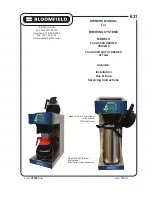
Heating control - user manual
www.solarcontrols.cz
Instructions for the installation and setup
of the device
Page 26 of 58
band, the heat pump runs on 100 %. If it is higher than this limit, the PID control runs. We
recommend that you choose the values 4 to 5 °C.
2.
In the two-state control mode (types according to b) it shows temperature hysteresis of the
switching of the heat pump. If the current control temperature is lower than the requested
temperature, the heat pump switches on. If the current control temperature is higher than
the requested temperature plus hysteresis, the heat pump switches off. We recommend that
you choose values 2 to 3 °C.
“Internal control request off-delay” – it shows the delay of the heat pump switching off if it is
activated by the internal control.
“Bivalent 1
st
level on-delay” – it shows the delay of the switching on of the 1
st
level of the bivalent heat
source from the moment when the internal control evaluates the conditions for its switching on.
“Bivalent 2
nd
level on-delay” – it shows the delay of the switching on of the 2
nd
level of the bivalent
heat source from the moment when the internal control evaluates the conditions for its switching on.
“Minimum inverter power” – it shows the minimum possible inverter input power for heat pumps
according to a). This value is used as protection against unwanted switching off of the heat pump in
the course of the internal control.
“Time schedules” – it shows a dialog with the setting of time schedules – see the Chapter “
Chyba!
enalezen zdroj odkazů.
.
1.
The temperature mode can be used for time-limited setting of the requested control
temperature.
2.
The restricted mode concerns all outputs (heat pump and bivalent source).
3.
The enforced mode concerns only the heat pump control output.
“Equitherm curve” – it shows a dialog with the setting of the equitherm curve – see the Chapter
“
Chyba! Nenalezen zdroj odkazů.
.
SOLID FUELS TAB
It includes control blocks for solid fuel boilers or possibly fireplace inserts which do not have their own
electronic control.
Note:
This function is available only with the activated SW extension Solid Fuel Boilers.
The boiler is controlled in 2 ways which can mutually overlap or complement each other:
a)
Control according to the output temperature steepness – it is used for seizing the rise of the output
temperature during the start of heating or the following operation of the boiler. The steepness (1
st
derivation) of the output temperature must exceed the set limit. It will be useful especially if we have
only the output temperature sensor at the boiler.
b)
Control according to temperature difference – it is used in the subsequent boiler operation. The
circulation pump switches on only when the difference between the output and input temperature
exceeds a certain limit and it switches off when the difference drops under a certain limit. It will be
useful only if both temperature sensors are connected.
Description of configuration and status elements:
“Input – input temperature” – the temperature sensor on the pipe entering the boiler. It is not
obligatory, but its use is recommended. If it is not used, only the control according to a) will be used.
















































